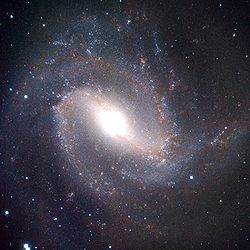- Messier 83
-
Messier 83 
An ESO image of Messier 83.
Credit: ESO.Observation data (J2000 epoch) Constellation Hydra Right ascension 13h 37m 00.9s[1] Declination -29° 51′ 57″[1] Redshift 513 ± 2 km/s[1] Distance 14.7 Mly (4.5 Mpc)[2] Type SAB(s)c[1] Apparent dimensions (V) 12′.9 × 11′.5[1] Apparent magnitude (V) 7.54[3][4] Other designations NGC 5236,[1] UGCA 366,[1] PGC 48082,[1] Southern Pinwheel Galaxy[5] See also: Galaxy, List of galaxies Messier 83 (also known as the Southern Pinwheel Galaxy, M83 or NGC 5236) is a barred spiral galaxy[6] approximately 15 million light-years away in the constellation Hydra. It is one of the closest and brightest barred spiral galaxies in the sky, making it visible with binoculars. Six supernovae (SN 1923A, SN 1945B, SN 1950B, SN 1957D, SN 1968L and SN 1983N) have been observed in M83.
Contents
History
Pierre Méchain discovered M83 in 1752 at the Cape of Good Hope.[7] Charles Messier added it to his catalogue of nebulous objects (now known as the Messier Catalogue) in March 1781.[7]
On 16 June 2008 NASA's Galaxy Evolution Explorer project reported finding large numbers of new stars in the outer reaches of the galaxy. It had hitherto been thought that these areas lacked the materials necessary for star formation.[8]
Nearby galaxies and galaxy group information
M83 is at the center of one of two subgroups within the Centaurus A/M83 Group, a nearby group of galaxies.[2] Centaurus A is at the center of the other subgroup. These two groups are sometimes identified as one group[9][10] and sometimes identified as two groups.[11] However, the galaxies around Centaurus A and the galaxies around M83 are physically close to each other, and both subgroups appear not to be moving relative to each other.[12]
See also
- Pinwheel Galaxy - a similar face-on spiral galaxy
- M83 - a French experimental rock band named after the galaxy
References
- ^ a b c d e f g h "NASA/IPAC Extragalactic Database". Results for NGC 5236. http://nedwww.ipac.caltech.edu/. Retrieved 2006-12-08.
- ^ a b I. D. Karachentsev, M. E. Sharina, A. E. Dolphin, E. K. Grebel, D. Geisler, P. Guhathakurta, P. W. Hodge, V. E. Karachetseva, A. Sarajedini, P. Seitzer (2002). "New distances to galaxies in the Centaurus A group". Astronomy and Astrophysics 385 (1): 21–31. Bibcode 2002A&A...385...21K. doi:10.1051/0004-6361:20020042.
- ^ "SIMBAD-M83". SIMBAD Astronomical Database. http://simbad.u-strasbg.fr/simbad/sim-id?Ident=M83. Retrieved 2009-11-29.
- ^ Armando, Gil de Paz; Boissier; Madore; Seibert; Boselli et al. (2007). "The GALEX Ultraviolet Atlas of Nearby Galaxies". Astrophysical Journal (ApJS) 173 (2): 185–255. arXiv:astro-ph/0606440. Bibcode 2007ApJS..173..185G. doi:10.1086/516636.
- ^ "SIMBAD astronomical database". Results for M83. http://simbad.u-strasbg.fr/simbad/. Retrieved 2007-05-02.
- ^ "Multimedia Gallery: M83 - Southern Pinwheel Galaxy". NASA/JPL-Caltech/WISE Team. 25 June 2010. http://wise.ssl.berkeley.edu/gallery_M83_Pinwheel.html.
- ^ a b K. G. Jones (1991). Messier's Nebulae and Star Clusters (2nd ed.). Cambridge: Cambridge University Press. ISBN 0-521-37079-5.
- ^ "Stellar Birth in the Galactic Wilderness". http://www.nasa.gov/mission_pages/galex/galex-20080416.html.
- ^ R. B. Tully (1988). Nearby Galaxies Catalog. Cambridge: Cambridge University Press. ISBN 0-521-35299-1.
- ^ P. Fouque, E. Gourgoulhon, P. Chamaraux, G. Paturel (1992). "Groups of galaxies within 80 Mpc. II - The catalogue of groups and group members". Astronomy and Astrophysics Supplement 93: 211–233. Bibcode 1992A&AS...93..211F.
- ^ A. Garcia (1993). [bibcode=1993A&AS..100...47G "General study of group membership. II - Determination of nearby groups"]. Astronomy and Astrophysics Supplement 100: 47–90. Bibcode 1993A&AS..100...47G. bibcode=1993A&AS..100...47G.
- ^ I. D. Karachentsev (2005). "The Local Group and Other Neighboring Galaxy Groups". Astronomical Journal 129 (1): 178–188. arXiv:astro-ph/0410065. Bibcode 2005AJ....129..178K. doi:10.1086/426368.
External links
- ESO Photo Release eso0136, An Infrared Portrait of the Barred Spiral Galaxy Messier 83
- M83, SEDS Messier pages
- Spiral Galaxy Messier 83 at the astro-photography site of Mr. Takayuki Yoshida.
- M83 The Southern Pinwheel
- Messier 83 on WikiSky: DSS2, SDSS, GALEX, IRAS, Hydrogen α, X-Ray, Astrophoto, Sky Map, Articles and images
Coordinates:
 13h 37m 00.9s, −29° 51′ 57″
13h 37m 00.9s, −29° 51′ 57″Messier objects List M1 · M2 · M3 · M4 · M5 · M6 · M7 · M8 · M9 · M10 · M11 · M12 · M13 · M14 · M15 · M16 · M17 · M18 · M19 · M20 · M21 · M22 · M23 · M24 · M25 · M26 · M27 · M28 · M29 · M30 · M31 · M32 · M33 · M34 · M35 · M36 · M37 · M38 · M39 · M40 · M41 · M42 · M43 · M44 · M45 · M46 · M47 · M48 · M49 · M50 · M51 · M52 · M53 · M54 · M55 · M56 · M57 · M58 · M59 · M60 · M61 · M62 · M63 · M64 · M65 · M66 · M67 · M68 · M69 · M70 · M71 · M72 · M73 · M74 · M75 · M76 · M77 · M78 · M79 · M80 · M81 · M82 · M83 · M84 · M85 · M86 · M87 · M88 · M89 · M90 · M91 · M92 · M93 · M94 · M95 · M96 · M97 · M98 · M99 · M100 · M101 · M102 · M103 · M104 · M105 · M106 · M107 · M108 · M109 · M110See also Categories:- Spiral galaxies
- Barred spiral galaxies
- Centaurus A/M83 Group
- Hydra constellation
- Messier objects
- NGC objects
- PGC objects
Wikimedia Foundation. 2010.



